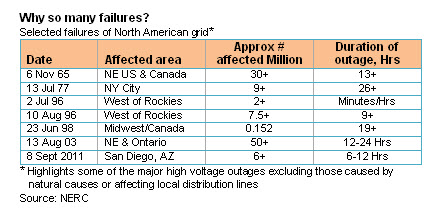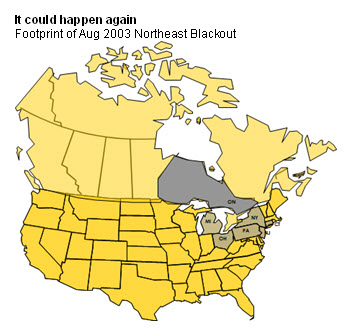This is a sample article from the November 2011 issue of EEnergy Informer.
Our existing grid is not as reliable as one would expect. What is the cure?
With no warning some 6 million residents across a wide stretch of Southern California, Southwest Arizona and the northern top of Baja California in Mexico lost power on 8 September 2011. It took hours to restore power. Coming a mere 8 years after the much bigger blackout affecting over 50 million people in Northeast US and province of Ontario in Canada in Aug 2003, it reminded anyone who needed reminding that the US electric grid is not as reliable or dependable as one would expect it to be.
The fragility of the grid, of course, is not limited to America. Similar accidents afflict other regions of the world, to varying degrees. Smaller failures, like smaller earthquakes common in California, are simply too frequent to get much publicity.

The reality, however, is that the grid fails with regularity, and the failures are commonly blamed on faulty equipment and human error – as in the case of the most recent one, which has been blamed on a maintenance worker at North Gila sub-station near Yuma, Arizona. What ever the reason, a critical 500 kV line was inadvertently knocked off, causing massive chaos in generation-poor San Diego region, which is dependent on power imported from the East and the North.
Within seconds – it quickly gets complicated – a dozen major power plants including 2 big reactors at San Onofre Nuclear Generating Station, operated by Southern California Edison Company, shut down, as designed, to protect their equipment from damage from the cascading failure. With so much generation out so abruptly, and so little back-up generation available to fill the void, the grid crashed, and left millions in the dark for the night. It could have been much worse.
An investigation is underway by the North American Electric Reliability Corporation (NERC) and Federal Energy Regulatory Commission (FERC). One or more reports will be published once the cause of the accident is determined. Recommendations will be issued, some followed, others ignored, until the next accident. We know the routine by now.
Partially in response to these frequent failures of the high voltage grid, which are to be distinguished from far more frequent and even more annoying failures of the low voltage distribution network — which are routinely experienced following every major and many minor storms — many millions of dollars are invested in the cure all, broadly defined as the smart grid. Chief among its many purported benefits are increased reliability, fewer and more manageable failures, and faster service restoration when failures do occur.

Smart grid, of course, will not be the panacea for all the grid’s woes, but any improvement is better than none. The question, as always, boils down to “at what cost and to what end?” Studies of the cost-effectiveness of the smart grid generally conclude that the ultimate gains will exceed the costs. But even if one agrees with the results of such analyses, it remains to be seen who bears the costs and who gains the benefits – since the incidence of the costs and benefits tend to be uneven among the affected stakeholders.
Is investment in smart grid smart?
The answer depends on who you ask, and certainly on who pays for the investments and who reaps the benefits.
A case in point is The Energy Infrastructure Modernization Act, authorizing a multi-year, multi-billion dollar investment to modernize the grid in the state of Illinois. The bill, which was to take effect in 2012 and run through 2021, passed both chambers of Illinois General Assembly in May 2011 but was rejected by Illinois Governor Pat Quinn in September. It would have made it easier for state’s utilities to recoup their investments in smart meters and smart grid initiatives by passing on the costs to customers.
Citing that there were “no guarantees of improved service” in the proposed rollout of smart meters and related grid improvements, Gov. Quinn said, “I will not support a bill that contains sweetheart deals for big utilities, which could leave struggling consumers to pick up the tab for costs such as lobbying fees and executive bonuses.”
Referring to recent service interruptions in Illinois, Gov. Quinn said, “More than 1.5 million people and businesses have had to deal with power outages and service disruptions this summer,” adding, “Now these same utilities are trying to change the rules to guarantee themselves annual rate increases and eliminate accountability.” Ouch.
The state’s biggest utility, Commonwealth Edison Company (ComEd), a unit of Chicago-based Exelon, disputed the governor’s assessment, pointing to a study by consulting firm Black & Veatch that, among other things, claims that ComEd customers could save $2.8 billion on their electric bills over the 20-year life of the meters. As it turns out, the lawmakers were able to override the Governor’s veto, allowing the bill to proceed.
ComEd’s CEO, Anne Pramaggiore, said, “As other states are building more efficient and reliable electric grids, Illinois is in danger of falling behind.” In a press release, ComEd also referred to a July 2011 white paper by the Institute for Electric Efficiency, covered in October issue of this newsletter, which concluded that investments in smart meters and related peripherals are cost-effective.
Smart Grid Book
A recent book, Smart Grid: Integrating Renewable, Distributed, and Efficient Energy, edited by Dr. Sioshansi, explores the many dimensions of the smart grid (see brochure). With contributions from a number of prominent experts, scholars and practitioners with different perspectives, the book provides a broad coverage of the what, how, when, why and other facets of the smart grid. You can currently get 35% off the purchase price via Gridwise.

